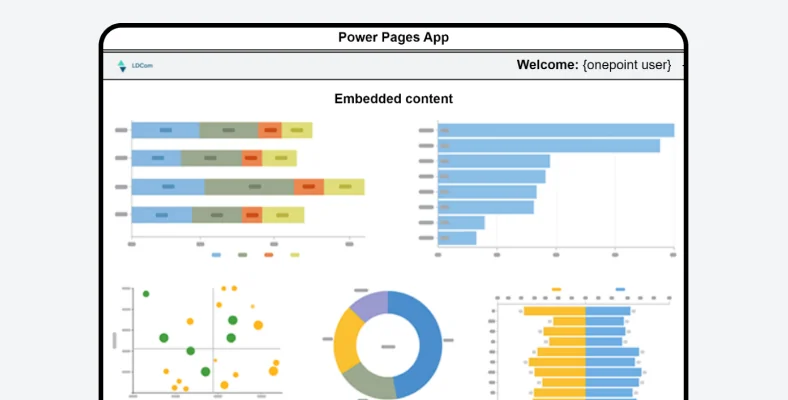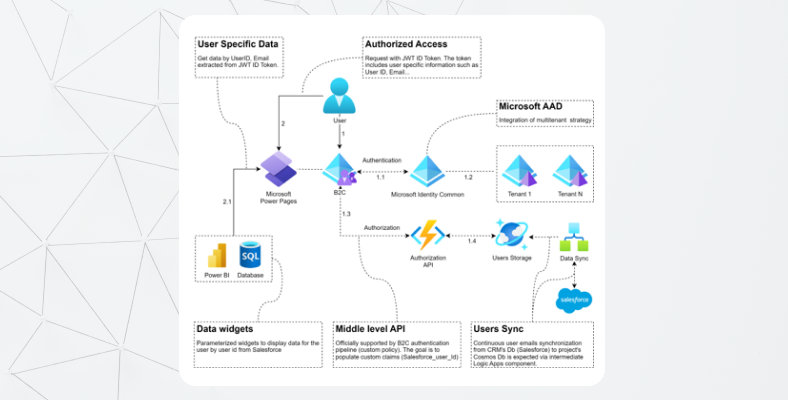Project background
Our client, a proficient Azure enterprise specializing in client support, consulting, and cost management, manages a diverse range of requests from clients seeking tailored reports. At the heart of their operations lies the One Point SaaS management platform, an essential component within their ecosystem of applications and services.
Designed to integrate Microsoft organizational users with the company’s vast Big Data resources, the platform is a pivotal tool for authentication, authorization, and secure communication. However, despite their Azure expertise and strategic focus on Big Data solutions, our client needs help in actual development.
With limited in-house development expertise, they need help creating custom solutions tailored to individual client needs. Integration into existing systems poses further hurdles, hindering the seamless incorporation of Big Data solutions into client workflows. Consequently, the inability to customize solutions leaves our client with a one-size-fits-all approach that falls short of meeting the unique requirements of their clientele.
To address these challenges, our proposed solution aims to enhance our client’s company’s development capabilities while optimizing their Big Data solutions for maximum effectiveness. By leveraging our expertise in software development and Big Data integration, we will collaborate closely with our client to overcome their current limitations and unlock new opportunities for growth.
- Duration: September 2023 - Ongoing
- Location: Europe
- Industry: Big Data Analysis Consulting
Business needs
The One Point SaaS management platform project is structured around four primary business objectives:
01
Establishing a centralized repository of information for clients: This consolidation of data will enhance our position as a leading Cloud Service Provider (CSP) partner in the market and increase our attractiveness to potential stakeholders.
02
Enabling business initiatives and opportunities for users of various Microsoft organizations.
03
Improving user experience.
04
Reducing support and maintenance costs by modernizing technology.
Despite our client’s focus on Big Data solutions, their lack of development experience presents significant challenges:
– Limited In-House Development Expertise: The absence of development experience inhibits the company’s ability to create customized solutions tailored to specific client needs.
– Integration Challenges: Integrating Big Data solutions into existing systems or workflows is complex without a strong development background, making seamless integration with clients’ infrastructure a struggle.
– Inability to Customize Solutions: Customization is vital in Big Data projects to meet unique business requirements. However, the company’s lack of development expertise limits their ability to tailor solutions, resulting in a one-size-fits-all approach that may not fully meet clients’ specific needs.
Product features
– Manage all user identities in a single B2C tenant.
– User identities are multi-tenant Microsoft accounts.
– Provide a convenient B2C authorization model with a single user account (its email) based on the modern OpenID Connect authentication protocol.
– Use the email address (principal name) as a user identifier. The email address should be a valid email address that the user has access to.
– Do not store passwords or any sensitive account information on the B2C side.
– The account authentication flow and details such as branding, Multi-Factor Authentication (MFA) scenarios, etc., should entirely depend on the user’s organization rules.
– Support web client applications.
– Automatic user info enhancement.
– Access Control shall be independent of the user’s parent organization. For example, a user from one organization should be able to access resources of the customer organization if proper access rights are granted.
– Ability to authorize using the company’s CRM system via intermediate storages, extending the identity token of the current user with application-specific claims.
– Ability for User Management (edit/extend information about the user).
– Integration with new Microsoft Power Pages application: Placing of Power BI widget provided by the Customer in Power Pages application.






